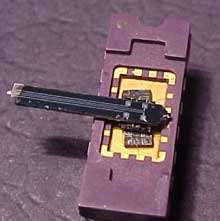Tiny atomic battery developed at Cornell could run for decades unattended, powering sensors or machines

The prototype device uses a copper cantilever 2 centimeters long. Future nanofabricated versions could be smaller than one cubic millimeter. <br><a target=extern href=http://www.news.cornell.edu/Utilities/Copyright.html>Copyright © Cornell University </a>
While electronic circuits and nanomachines grow ever smaller, batteries to power them remain huge by comparison, as well as short-lived. But now Cornell University researchers have built a microscopic device that could supply power for decades to remote sensors or implantable medical devices by drawing energy from a radioactive isotope.
The device converts the energy stored in the radioactive material directly into motion. It could directly move the parts of a tiny machine or could generate electricity in a form more useful for many circuits than has been possible with earlier devices. This new approach creates a high-impedance source (the factor that determines the amplitude of the current) better suited to power many types of circuits, says Amil Lal, Cornell assistant professor of electrical and computer engineering.
Lal and Cornell doctoral candidate Hui Li described a prototype of the device at a U.S. Department of Defense meeting of Defense Advanced Research Projects Agency (DARPA) investigators in Detroit in August. The prototype is the first MEMS (micro-electromechanical systems) version of a larger device that Lal designed and built while a member of the faculty at the University of Wisconsin, Madison, working with nuclear engineering professors James Blanchard and Douglas Henderson.
The prototype is made up of a copper strip 1 millimeter wide, 2 centimeters long and 60 micrometers (millionths of a meter) thick that is cantilevered above a thin film of radioactive nickel-63 (an isotope of nickel with a different number of neutrons from the common form). As the isotope decays, it emits beta particles (electrons). Radioactive materials can emit beta particles, alpha particles or gamma rays, the last two of which can carry enough energy to be hazardous. Lal has chosen only isotopes that emit beta particles, whose energy is small enough not to penetrate skin, to be used in his device.
The emitted electrons collect on the copper strip, building a negative charge, while the isotope film, losing electrons, becomes positively charged. The attraction between positive and negative bends the rod down. When the rod gets close enough to the isotope, a current flows, equalizing the charge. The rod springs up, and the process repeats. The principle is much like that underlying an electric doorbell, in which a moving bar alternately makes and breaks the electric circuit supplying an electromagnet that moves the bar.
Radioactive isotopes can continue to release energy over periods ranging from weeks to decades. The half-life of nickel-63, for example, is over 100 years, and Lal says a battery using this isotope might continue to supply useful energy for at least half that time. (The half-life is the time it takes for half the atoms in an element to decay.) Other isotopes offer varying combinations of energy level versus lifetime. And unlike chemical batteries, the devices will work in a very wide range of temperatures. Possible applications include sensors to monitor the condition of missiles stored in sealed containers, battlefield sensors that must be concealed and left unattended for long periods, and medical devices implanted inside the body.
The moving cantilever can directly actuate a linear device or can move a cam or ratcheted wheel to produce rotary motion. A magnetized material attached to the rod can generate electricity as it moves through a coil. Lal also has built versions of the device in which the cantilever is made of a piezoelectric material that generates electricity when deformed, releasing a pulse of current as the rod snaps up. This also generates a radio-frequency pulse that could be used to transmit information. Alternatively, Lal suggests, the electrical pulse could drive a light-emitting diode to generate an optical signal.
In addition to powering other devices, the tiny cantilevers could be used as stand-alone sensors, Lal says. The devices ordinarily operate in a vacuum. But the sensors might be developed to detect the presence or absence of particular gases, since introducing a gas to the device changes the flow of current between the rod and the base, in turn changing the period or amplitude of the oscillation. Temperature and pressure changes also can be detected.
Lal, Li and Cornell doctoral candidate Hang Guo are now building and testing practical sensors and power supplies based on the concept. The prototype shown in August was gigantic by comparison with the latest versions, Lal says. An entire device, including a vacuum enclosure, could be made to fit in less than one cubic millimeter, he says.
Media Contact
More Information:
http://www.news.cornell.edu/All latest news from the category: Power and Electrical Engineering
This topic covers issues related to energy generation, conversion, transportation and consumption and how the industry is addressing the challenge of energy efficiency in general.
innovations-report provides in-depth and informative reports and articles on subjects ranging from wind energy, fuel cell technology, solar energy, geothermal energy, petroleum, gas, nuclear engineering, alternative energy and energy efficiency to fusion, hydrogen and superconductor technologies.
Newest articles

NASA: Mystery of life’s handedness deepens
The mystery of why life uses molecules with specific orientations has deepened with a NASA-funded discovery that RNA — a key molecule thought to have potentially held the instructions for…

What are the effects of historic lithium mining on water quality?
Study reveals low levels of common contaminants but high levels of other elements in waters associated with an abandoned lithium mine. Lithium ore and mining waste from a historic lithium…

Quantum-inspired design boosts efficiency of heat-to-electricity conversion
Rice engineers take unconventional route to improving thermophotovoltaic systems. Researchers at Rice University have found a new way to improve a key element of thermophotovoltaic (TPV) systems, which convert heat…



